Can I Glue a Tub Surround Over Existing Tile? Yes & Here's How
Author: Omar Alonso | Editor: Omar Alonso
Review & Research: Jen Worst & Chris Miller
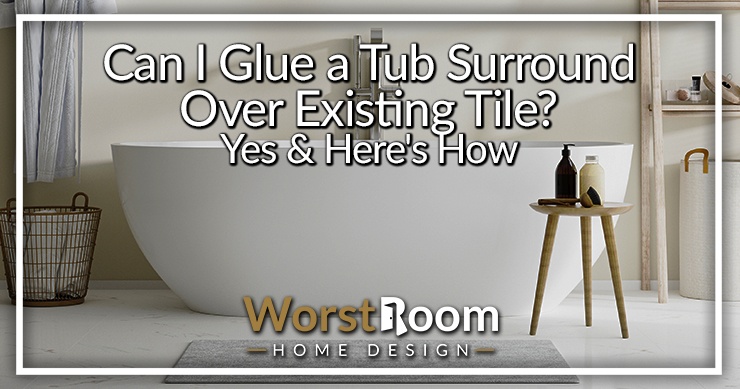
Are you considering a bathroom upgrade but don't want to deal with the hassle of removing your existing tile? You're asking "can I glue a tub surround over existing tile?" Yes, and it may be the perfect time-saving solution for you.
Here, we'll explore whether it's possible, weigh the pros and cons, discuss adhesive options, and provide helpful tips for successful installation.
Can You Install a Tub Surround Over Existing Tile?
You tiled over the drywall in your bathroom and now you want to install a tub surround. Yes, it is possible to install a tub surround over existing tile, but it's important to weigh the pros and cons and choose the right adhesive based on the condition of the existing tile.
Weighing the Pros & Cons
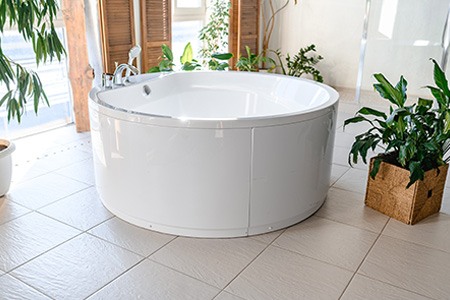
One of the primary advantages of installing a tub surround over existing tile is its cost-effective nature. This remodeling approach can save homeowners time, effort, and money compared to removing old tiles and starting from scratch.
Simple tub surrounds may come as low as $50, while luxury vinyl tile options provide an affordable yet stylish finish for your bathroom renovation project.
However, it's crucial to consider potential downsides before proceeding with this option. The condition of the existing tiles plays a significant role in determining whether installing a tub surround will be successful or not.
If the underlying tiles are unstable or damaged, there's a risk that the adhesive won't adhere properly, resulting in compromised installation integrity. In such cases, addressing potential moisture or mold issues becomes imperative.
Choosing the Right Adhesive
Selecting the appropriate adhesive for installing a tub surround over existing tile is crucial to ensure a strong bond and long-lasting results. Thinset mortar and epoxy mortar are two popular choices for high-moisture areas like showers, as they provide exceptional adhesion even in damp environments.
Before making your decision, consider factors such as the type of tub surround material you are using (e.g., acrylic or fiberglass), the condition of the existing tiles, and whether any additional waterproofing layers will be necessary. Even consider the size and amount you'll need, which will be different between a large luxury tub and smaller corner shower dimensions.
Consulting with a professional installer may help in understanding the specific requirements for your bathroom renovation project.
Evaluating the Condition of Existing Tile
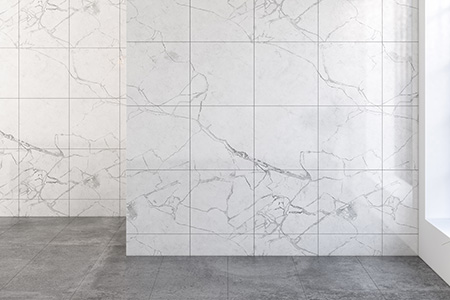
Can I glue a tub surround over existing tile? Yes, but it all depends on the shape of that existing tile. Is it cracked? Does the grouting need repair or replacement? Is there mold and mildew that needs cleaning?
Before you proceed with gluing a tub surround over your existing tile, it's crucial to evaluate the condition of the current surface. Start by inspecting for any loose, cracked, or damaged tiles, as these could compromise the integrity of your new installation.
Next, assess whether there is any mold or mildew present on the old tile surface. This can be harmful to both your health and your home if it isn't addressed properly. Ensure that any necessary treatment is completed before moving forward with the project.
In addition, check for unevenness in the existing tile layout – ideally; you want a flat surface for easy application of adhesive and seamless fitting of the new tub surround. Watch especially for how you tiled the inside corners, which can be more rough.
Keeping these factors in mind will help ensure that you're well prepared to tackle this project while promoting an effective bond between old tile and new tub surround materials such as acrylic or fiberglass panels.
How to Glue a Tub Surround Over Existing Tile
To glue a tub surround over existing tile as a shower tile alternative, start by thoroughly cleaning and preparing the surface, evaluating the condition of the tile, selecting the right adhesive (such as thinset mortar or epoxy mortar for high-moisture areas), following manufacturer instructions, allowing sufficient curing time, and properly using caulk to seal out water.
Surface Preparation & Cleaning
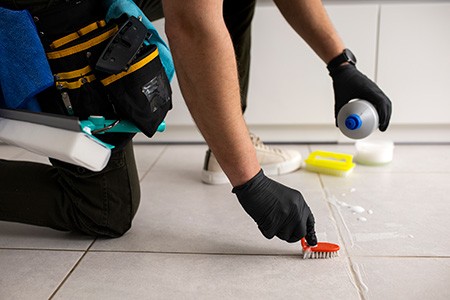
Before attempting to glue a tub surround over existing tile, proper surface preparation and cleaning are essential for a successful installation. The first step is to clean the existing tile thoroughly, removing any dirt, grime, or soap scum buildup.
For tougher stains or residue, use an abrasive cleaner or vinegar solution to scrub the tiles.
It's important to note that if there are any cracks or loose tiles on the existing wall surfaces, those should be repaired before installing a new tub surround. If not repaired correctly prior to gluing in place your results may quickly degrade.
Additionally always make sure you have checked with manufacturers instructions regarding safe usage of adhesives on your specific wall type as some walls could react negatively causing dangerous chemical reactions leading straight into loss of life including severe bodily harm especially when caution has been foregone during installation procedures.
Evaluate the Tile Condition
Before installing a tub surround over existing tile, it's essential to evaluate the condition of the tiles. Look for any cracks, chips or loose tiles that could compromise the stability of the installation.
If you find any loose tiles, ensure they are glued back in place before proceeding with the installation. Additionally, sanding and de-glossing old tiles can help panel sealant adhere better to create a smooth surface for your new tub surround.
It's also important to check if there are potential moisture and mold issues on the existing tile that may impact the durability of your new installation. So, can I glue a tub surround over existing tile? Yes, but you need to make sure that tile is in good condition first.
Select the Right Adhesive
Choosing the right adhesive is crucial when installing a tub surround over existing tile. Polyurethane adhesives are highly recommended for this type of project because they provide a strong bond and excellent water resistance.
An example of such adhesive is Loctite Power Grab Adhesive which is perfect for plastic tub surrounds in both shower and bath projects. When using any adhesive, always ensure you follow the manufacturer's instructions carefully to achieve the best possible results.
Follow the Manufacturer's Instructions
One important thing to keep in mind when installing a tub surround over existing tile is to follow the manufacturer's instructions. The adhesive and installation process can vary depending on the type of panel being used, so it's important to carefully read and understand the instructions before beginning the installation process.
For example, some types of panels may require a specific adhesive or additional preparation steps like de-glossing or repairing loose tiles before application. One recommended option for tub surround adhesive is DAP's DynaGrip® Tub Surround Adhesive.
Allow Sufficient Curing Time
After installing a tub surround over existing tile, it is crucial to allow sufficient curing time for the adhesive to fully set before using the tub or shower. The recommended drying time may vary depending on the adhesive used, but it is usually at least 24 hours.
A good example of an adhesive that requires sufficient curing time is Loctite Power Grab Tub Surround. This product has been specifically designed for use in wet environments and resists moisture, steam, water, heat, or cold when fully cured.
It's important to follow the manufacturer's instructions for application and cure times to ensure a successful installation that will stand up over time.
Tips for a Successful Tub Surround Installation
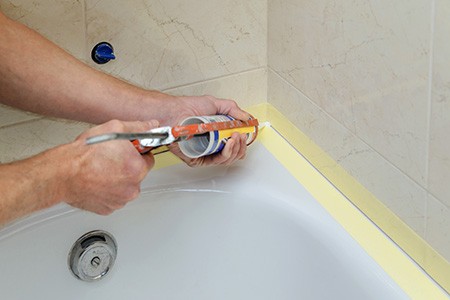
We've covered the answer to can you install a tub surround over existing tile and are now on to how to do so correctly. Proper use of caulk is crucial for sealing any gaps between the surround and the tub or walls, while checking for leaks should be done after installation to ensure there are no issues.
Proper Use of Caulk
A proper caulk application is essential for a successful tub surround installation. The gaps between the panels must be filled in with a waterproof sealant to prevent water from seeping through and causing damage.
There are various types of caulking materials available for wet environments, such as 100% silicone caulk and siliconized acrylic caulk. Flex Shot is an excellent option when caulking your bathroom without using a gun.
It's also essential to allow sufficient drying time after installing the tub surround before applying any caulk or making further modifications. Don't stress, later you can caulk over caulk until it's build-up is too much and you have to remove it and start over.
Checking for Leaks
One of the most important steps in installing a tub surround over existing tile is checking for leaks. Proper waterproofing ensures that water does not seep through gaps and cause damage to walls and floors, leading to mold and mildew growth.
You can start by applying sealant around the edges of the tub surround to create a tight seal against water penetration. Additionally, you can carry out a simple check for leaks after installation by running water into the shower area or filling it with water above the level of any joints, seams, or fixtures for about 10-15 minutes while observing possible signs of leakage like drips or moisture build-up on surrounding surfaces.
Addressing Potential Moisture & Mold Issues
Proper installation of a tub surround over existing tile can help prevent moisture and mold issues in your bathroom. Applying a high-quality waterproof adhesive is essential, as it creates a barrier against water damage.
However, besides the adhesive, several other factors need to be considered to avoid fungal growth with a tub surround over tile.
Additionally, caulking around the edges between the wall and the tub-surround is vital to keep out moisture that could seep through joints and lead to mold growth behind tiles or drywalls.
Regularly inspecting and sealing grout lines can also reduce water infiltration and fungal growth potential with shower surrounds over tile.
Key Tub Surround Takeaways Regarding Tile
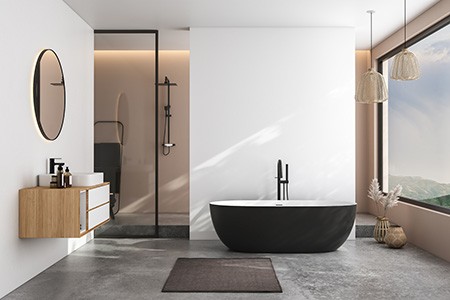
- Gluing a tub surround over existing tile is possible, but it's important to weigh the pros and cons and evaluate the condition of your existing tiles before proceeding with this option.
- Choosing the right adhesive is crucial for ensuring a strong bond between old tile surfaces and new tub surrounds. Thinset and epoxy mortar are popular options suitable for high-moisture areas like showers.
- Proper surface preparation, cleaning, and following manufacturer instructions are key to a successful installation. Additionally, allowing sufficient curing time after installation as well as properly using caulk can help prevent leaks or other issues down the line.
- Checking for potential moisture or mold issues on existing tiles before installing new ones is essential in promoting long-lasting results while avoiding future complications. Regular maintenance such as refreshing caulking also ensures continued protection from unwanted water intrusion.
So, Can I Glue a Tub Surround Over Existing Tile?
In conclusion, the answer to whether you can glue a tub surround over existing tile is yes! By following these simple steps and using the right adhesive, installing a new tub surround can be a DIY project that saves time and money.
But before doing it yourself, weigh the pros and cons of this option as well as evaluate if your existing tiles are in good condition. Remember to take necessary precautions for water sealing by using corner pieces or edge seals to avoid any potential moisture or mold issues down the line. So can I glue a tub surround over existing tile? You bet.



